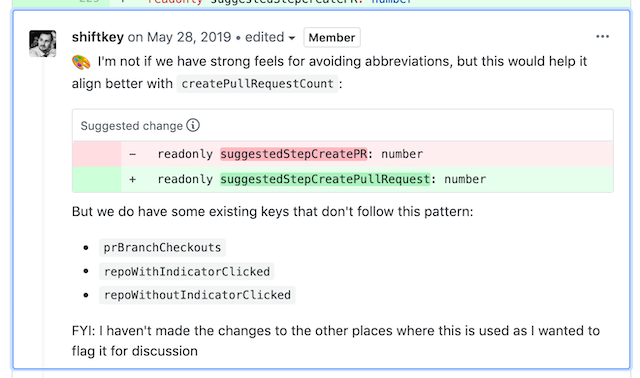I do a lot of reviews of pull requests on GitHub, and as soon as they require more than a single comment I try and prefix the comments with an emoji character to help categorize each bit of feedback.
Here’s an example of how it looks in action:

I’ll save the details and my opinions about code review itself for another post, as I think this guide can stand on it’s own.
I prefix comments with an emoji for a few reasons:
- Feedback can fall into a number of different categories, and not everything should be addressed immediately (or in the same way)
- Sometimes a piece of feedback doesn’t need to be addressed immediately before a pull request is merged, but it should be captured somewhere. Once we agree its something we should address, and figure out how/when to address it, we can move the feedback to a separate tracking issue for future work and merge the pull request
- I believe visual cues help the recipient to navigate the feedback of a thorough review containing many comments without being overwhelmed
Here’s the current set I use, and what each thing represents:
- 🎨
:art:- Context: this is a suggestion to improve the code, that shouldn’t affect the functional aspect but would help with readability/legibility
- Action: contributor may want to accept the change (yay suggested changes), may provide extra context about why they’re not interested in making the change, or may just dismiss the suggestion
- Status: not a blocker on merging
- 💭
:thought_balloon:- Context: there’s something about this change that I’m thinking about, and it’s not currently clear to me whether something needs to change here
- Action: input about the questions or ideas proposed, and whether there is extra relevant information that I’ve overlooked
- Status: currently not a blocker on merging, pending further discussion
- ❓
:question:- Context: I’m not clear about something and why it’s required
- Action: clarifying remarks from the contributor
- Status: tentatively a blocker on merging, pending more context
- 🚨
:rotating_light:- Context: I’m a bit nervous about this change and what it might introduce after merging, and would like to better understand why it is needed
- Action: discussion between contributor and reviewers
- Status: blocker on merging, pending further discussion
What does “blocker” mean?
With teams that are working asynchronously across timezones, it’s often hard to communicate which feedback that is considered blocking versus non-blocking:
- blocking: feedback must be resolved before merging
- non-blocking: optional feedback but pull request is fine to merge as-is
Sometimes you can submit a quick review with “Request changes” selected to block a pull request from being merged, but the teams I’ve been a member of in the past prefer to only use this in case of an emergency (overriding a previous approval), as we will protect the default branch to require an approval from someone else on the team from merging.
On teams containing a mix of senior and junior developers being able to provide detailed feedback in a review and indicate what is blocking feedback, without the “Request changes” end result, allows the contributor a chance to own their review process, discuss things with the reviewers and hopefully feel more in control of the situation.
What about proposing larger changes to the code?
You may notice there’s no item here for proposing significant changes to the pull request, and that’s a conscious decision for a few reasons:
- as a reviewer I should be helping guide the contributor to their goal, rather than getting too much into what the solution should be
- if the contributor gets stuck on something, or wants to pick my brain about something they’re working on, a pairing session (ideally virtually) is an option here to make some progress
- if there are significant things to address as part of a review, it’s on me as the reviewer to sync up and help the contributor identify the way forward before too much time and effort is spent on the pull request
- if there is an opportunity to improve the pull request that’s not necessarily in scope, we should discuss and confirm it’s worth spending time on, estimate when it should be addressed, and document it (e.g. as a new issue)
I believe there’s a skill to ensuring the software continues to work as expected versus empowering the contributor to achieve what they are working towards, but I think constraining the reviewer to focus on feedback means:
- allowing the contributor to focus on the problem at hand
- raising questions and suggestions as soon as possible
- helping ensure the contributor’s work aligns with how the project functions
- thinking about scenarios that may not be on the contributor’s radar